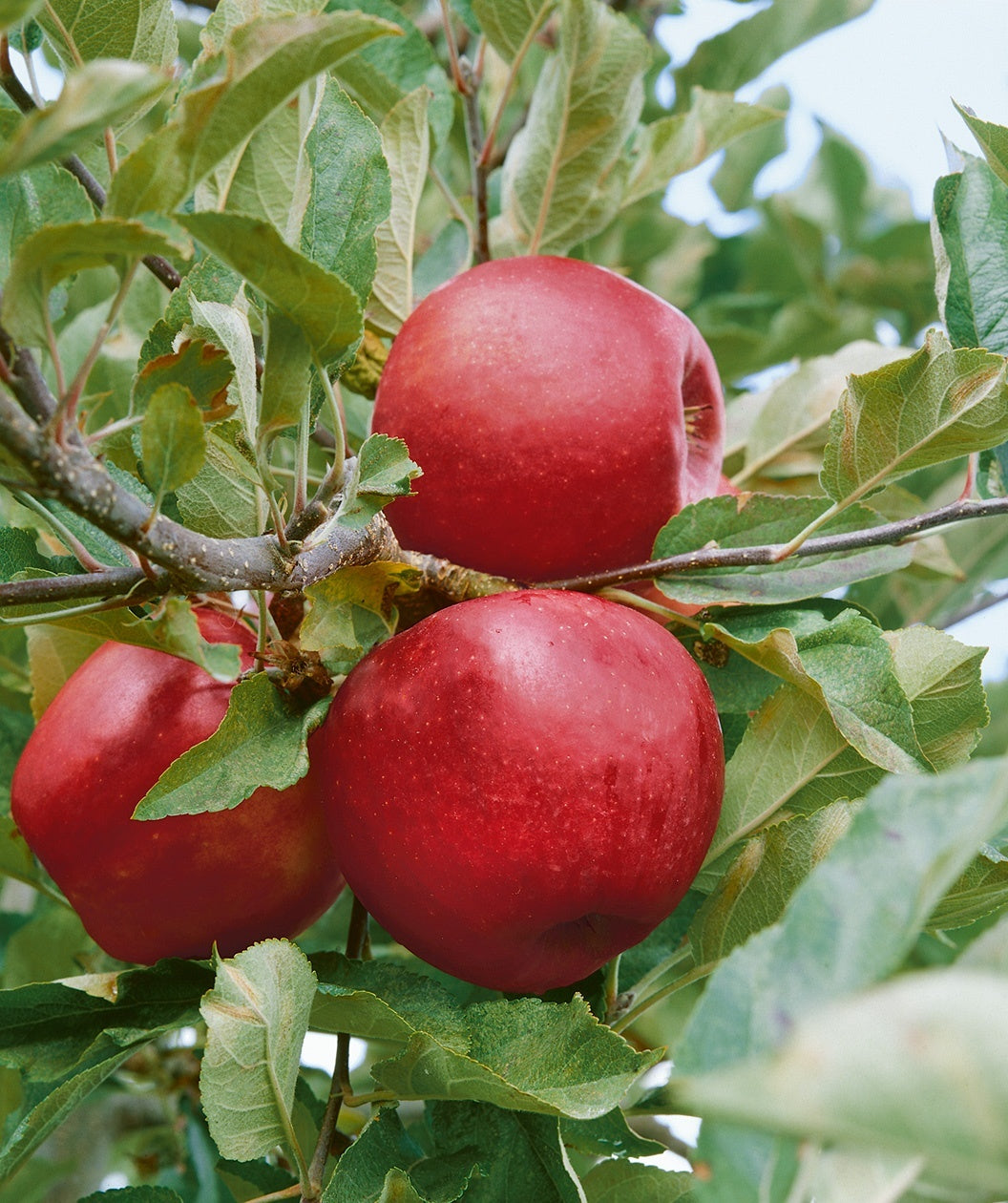

POLLINATOR FRIENDLY FRUIT BEARING TREE
FEATURES:
- Spring provides pink flower buds that open up revealing bright white blooms
- Foliage is bright green and lush come spring and summer
- In the fall, hues of yellow come before dormancy
- Medium sized apples appear following the blooms maturing in fall to bright red and ready to eat
- Happily invited birds and pollinators to your home for a snack
- Add fragrant spring blooms and delicious fruits to your property anywhere full sun is provided
- Braeburn, Gala, and Honeycrisp are the best apple varieties to pair for pollinations with the Empire Apple
- Hand Selected, Fresh from the Grower
- Ships on our trucks because of the size of the tree - does not fit in a box
Growth Facts
- Hardiness Zone: 4-8
- Mature Height: 12-15' tall
- Mature Width: 12-15' wide
- Exposure: Full Sun
- Spacing: 12-15' apart
POLLINATOR FRIENDLY FRUIT BEARING TREE
FEATURES:
- Spring provides pink flower buds that open up revealing bright white blooms
- Foliage is bright green and lush come spring and summer
- In the fall, hues of yellow come before dormancy
- Medium sized apples appear following the blooms maturing in fall to bright red and ready to eat
- Happily invited birds and pollinators to your home for a snack
- Add fragrant spring blooms and delicious fruits to your property anywhere full sun is provided
- Braeburn, Gala, and Honeycrisp are the best apple varieties to pair for pollinations with the Empire Apple
- Hand Selected, Fresh from the Grower
- Ships on our trucks because of the size of the tree - does not fit in a box
Growth Facts
- Hardiness Zone: 4-8
- Mature Height: 12-15' tall
- Mature Width: 12-15' wide
- Exposure: Full Sun
- Spacing: 12-15' apart
Why plant Empire Apple?
Empire is an apple known for its deep purple-red color, crisp but juicy texture, sweet and somewhat pineapple-y flavor, and its ability to be knocked around in lunch box without bruising. Empire apples also store well in the refrigerator, though the flavor is better when fresh—and you don’t get any fresher than picked off your own tree! If you’ve never grown Apple trees before, Empire is a good beginner’s tree, especially if you live in the Northeastern U.S., where this tree does best.
The Empire Apple was developed in the Empire State many years ago, and New York is still the area where this variety is primarily grown commercially. Lester Anderson of Cornell University crossed a McIntosh Apple with a Red Delicious Apple in 1945 to get the ball rolling, and more than 20 years and thousands of seedlings later, Empire was chosen for release. (This is why you probably shouldn’t bother growing Apple trees from seed—even after a carefully planned cross, you’ll get a LOT of duds!)
How to use Empire Apple in the landscape?
While some Apple trees only bear heavily every other year (“biennial bearing”), Empire has proven to be a reliable producer every year. Its fruits will keep until January in the fridge and are used for fresh snacking and in salads, pies, and applesauce.
Planting Zones
Hardiness Zone: 4-8
How To Plant Empire Apple
Your First Fruits™ Empire Apple tree is “partially self-fertile,” meaning that even without another pollinator tree nearby, it will set some fruit. To ensure optimum fruit set, you can plant a different Apple or Crabapple variety in your yard to contribute pollen. Empire blooms mid-season, and its flowering time overlaps with several Crabapples you may use as pollen donors, such as Royal Raindrops®, Prairie Fire, or Louisa. Always plant Apple trees in sunny sites with good air circulation to discourage disease. Irrigate regularly, but don’t overwater. Our fruit tree experts here at Bower & Branch™ are happy to answer any questions you have about Apple tree care. Please don’t hesitate to ask!
How To Water
Water deeply, and regularly during its first few years in the ground. Irrigate weekly, and especially during long dry spells or extreme heat after it’s established.
How To Fertilize
Incorporate Elements Starter Plant food granular form into the soil when planting. If planting in spring or summer, start fertilizing late fall using Elements Starter Plant food granular form on an annual basis each late fall. Continue this for the first three years to get your plant well established.
How To Prune
Always promptly remove and destroy any diseased branches, leaves, or fruit from your Apple tree and around the base. Leaving those in place could cause reinfection the following year.
Videos
How Does Shipping Work?
Bower & Branch Trees, the real BIG trees, don’t fit in a box! Our big trees, sizes XL and bigger, require expert delivery and care, that means our extra-large trees are shipped on Bower & Branch trucks. We are the only ones who know how to ship our big and bigger trees and plants with tender loving care. We deliver your trees and plants directly to you. Ask Bower & Branch about planting services – we'd be happy to assist in installation.
*For Big trees and Shrubs, Size XL and bigger: Review our Seasonal Shipping Timelines and Policy here.
Your trees and plants are grown across the United States at various Bower & Branch Growers. Depending on your location, your plant orders may be shipped from various locations. Please expect orders with multiple items to be delivered over a number of days as a result. Orders made up of numerous items or selections will not arrive at your home on the same day.
Shipping Delays:
From time to time, Bower & Branch Growers may determine to delay order shipment based on various factors for plant health. Weather in your region, as well as, where your plants are grown, is always considered when shipping. Extreme weather conditions may delay some or all of your order. Bower & Branch allows our Growers to make final shipping decisions based solely to benefit your trees and plants’ health and success.
How Does Sizing Work?
The size of our trees have nothing to do with the container size like you may find elsewhere–big doesn't mean just height - it’s also vigor, age, and overall health. Other online retailers are going to tell you that a plant is a seven gallon, that means nothing to your tree or plant (or you.)
Our trees for sale online are graded on large, x-large, and even bigger sizes. This is because our trees are sized by their age—the higher the letter, the more mature the tree. The age determines the trees’ overall height, size of the trunk and the overall branch density.
All of these characteristics are what you should be looking for when choosing a tree for immediate impact and instant curb appeal. Our extra-large tree and plant sizes are sure to wow you and your neighbors!
See the size guides below.






Our Guarantees
3-YEAR-TREE GUARANTEE:
Bower & Branch offers a Three-Year Tree Guarantee on all of our trees, sizes X-Large and up. Only the finest and the most experienced growers are awarded the opportunity to grow for Bower & Branch, so we offer the best guarantee available.
If your tree(s) should fail for any reason during the three-year guarantee period, you will receive an online gift card in the amount that you originally spent on the tree.* You can then use this online gift card for any Bower & Branch Purchase.
* Bower & Branch provides online gift cards in the amount of the original purchase price of the tree(s). The amount does not include any additional costs such as delivery, planting, tax, or any other products or services. Online gift cards can be applied towards any Bower & Branch purchase on BowerandBranch.com and have no expiration dates. Bower & Branch does not guarantee tree replacement or availability of any desired product at any time. Cash refunds are not offered. Bower & Branch requires that all original tags and receipts are present when a guarantee request is initiated. The Bower & Branch Three-Year Guarantee only applies to plant material that has been planted in the ground. Container plantings are NOT covered.
At Bower & Branch, we do our best to honor all guarantee fulfillment requests to ensure customer satisfaction. However, we reserve the right to refuse the request if the required guarantee steps were not satisfied. Bower & Branch also reserves the right to deny any guarantee fulfillment request that is made as a result of animal damage, problems with plant hardiness and zone issues, or acts of nature (snow storms, hurricanes, and similar).
Reach out to a Plant Whisperer with any questions:
- Email: plantwhisperers@bowerandbranch.com
- Phone: 866-873-3888
- Or via Online Chat





